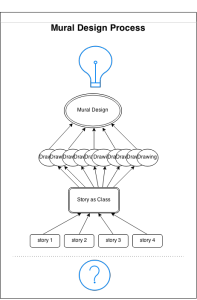With the topic of food security in mind and the Food for Free organization as our focus, our class set out to tell a story using national and local data, as well as data specific to Food for Free. From these numbers, we were to eventually paint a mural. How were we to turn these facts and figures into something more digestible and visually appealing, while also creating impact?
Our design process began first with finding and understanding the data that we want to present. By talking with a representative from Food for Free, we were able to gain a deeper insight into how the organization fit in with regards to the food security space, to gain a bit more personal connection and context for the data sheets we were provided.
From this data, we entered the process of drawing connections between the sets of data. We focused on finding different story types, like ‘factoids’ that stand out, ‘interactions’ that seem to correlate, ‘comparisons’ that reveal differences, changes’ that are significant, or ‘personal’ stories that connect to people. Here we sought out types of stories similar to those described by Rosenbaum in the Data Journalism Handbook. We didn’t necessarily look for a whole cohesive narrative yet – like Barr, we were simply poking around with our dataset attempting to make connections.
Once our groups put together our final conclusions, we combined our thoughts to determine the ‘story’ that this dataset told: that “Food for Free is growing our work with local partners to have greater impact on food security in Cambridge.”
It was at this point that we moved onto actually visualizing our data-set-turned-story. Through the use of some mapping and drawing exercises, we were able to isolate a few common symbols that we wanted to use to represent our story. From here, we were able to sketch out a rough mural, an image representing growth and reuse, using the symbols we determined.
Notably, as a mural, our process lead to a different type of narrative visualization. Segel and Heer sought to systematically describe and review different forms of data visualization, and even came up with seven ‘genres’ to do so. However, our mural doesn’t really fit into any genre they specify. Most of the case studies they examine contain maps, charts, and graphs, which have their own artistic direction and are designed purposefully to craft an easily digestible visual message.
Our mural instead will not contain graphs or numbers, or even text for that matter. Instead, our process produced a form of data-visualization that leaves more for the viewer to interpret. From here, we can definitely realize that their are many uniquely creative ways to tell stories backed with data – in this case, with art!
